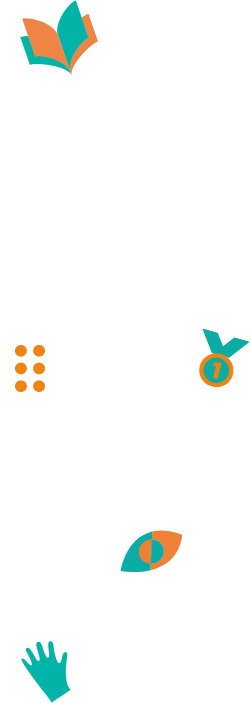Examples of award-winning books
The red and the blue -2022- - Karolina Banaszkiewicz Badura - Poland
“This is a very aesthetic and relevant book in its representation of forms.
- It stands out from the crowd in its treatment of the image. It gives the child other ways of reading tactile images and drawings.
- The text is charming.
- It is a finished and durable book that is very pleasant to touch.
- The book seems very interesting for a beginner reader, the text and the pictures match
- It does not weigh much, so it is easy to handle and certainly easy to edit.
- The colors are readable even for the visually impaired and the subject matter can help in learning to draw.
- It is a simple poetic book with a fluidity of touch and exploration.
- This book is out of the ordinary, it is original. It can allow the teacher to begin to help with the understanding of drawing.
- These lines show the child the power of lines and they allow children to build other lines.
- It stimulates the child’s imagination and helps them to be creative and imaginative.
- The simplicity of the reading remains amusing and the treatment of the drawing prominent. The story is well balanced.
Points for improvement:
- The book is a bit short and may lead to boredom or lack of interest on the part of the child, perhaps because of a lack of surprises. The colors blue and red are not always appropriate, it is a vocabulary for the eyes.
- There is little diversity of material and the lines are perhaps a little too prominent.
- It is not the criteria of a usual tactile book.
The jury’s opinion
Ausflug mitLangstock Lasse (Trip with long cane Lasse) -2022- - Johanna Kofler & Elena Braune - Germany
“It is a game book with sound recognition on an everyday object suitable for the visually impaired: the white cane.
Good points:
- The subject is well treated, it helps the child to understand the interest of the cane to move around.
- It’s a good topic idea and it’s unusual.
- There is a good comparison of scales, it helps to understand the reality of the environment.
- The point of talking about this object is to raise awareness among all children, so to share this situation between sighted and blind children.
- The choice of materials is relevant and there is a good tactile exploration possible.
- The evolution of complexity through the pages is like in life.
- The idea of highlighting the cane and loco motor skills gives the child seeing a little bit of power.
Points to improve:
- Maybe he lacks the way to walk. The child will do the process with his fingers and not necessarily the cane. Some materials are not always comfortable under the fingers. This sometimes gives less pleasure and therefore less appeal for reading.
- Finally, it’s a shame the story has no end.
The jury’s opinion
Pinpins et ses copains (Bunny and his buddies) - Marcelle Peeters & Monique Sommer - Belgium
“This is a book with a lot of tactile research behind it. The playful dimension gives added value to the book. Well-studied shapes help in learning shapes. The hero’s handicap becomes strength, children can identify with differently.” International Jury
Dag Spin (Hello Spider) - Gyntha Goertz & Ann Conefrey - Netherlands
“Well done, varied materials. We appreciate the pop-up of the end. The story is fluid and it is an attractive book. The writing is well adapted to a very young reader. Some pictures are sometimes inconsistent with the way of the reading. The thread of the spider is interrupted and it is a pity for the follow-up of the touch.” International Jury
Mamie Rose (Grandma Rose) - Tini CHOUVENC - France
“This is the first time that this subject (Alzheimer’s disease) has been tackled with great sensitivity and originality. This book is poetic. The images translate with humor the phases of the disease.” International Jury
































































